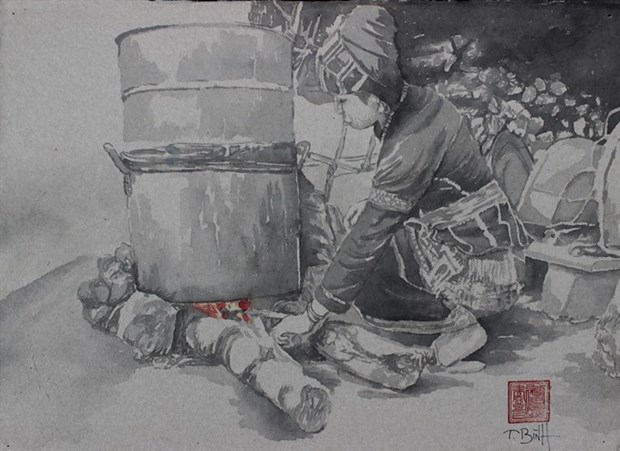Artist puts do paper paintings back on the map
Vu Thai Binh is confident showcasing his skills with do (poonah) paper at a painting exhibition in Hanoi’s Old Quarter Culture Exchange Centre that began on October 19.
 Lu Ethnic Girl - Lai Chau painting at size 40cm by 60cm (Photo: VNA)
Lu Ethnic Girl - Lai Chau painting at size 40cm by 60cm (Photo: VNA)Hanoi (VNA) – Vu Thai Binh is confident showcasing his skills with do (poonah) paper at a painting exhibition in Hanoi’s Old Quarter Culture Exchange Centre that began on October 19.
The Colour of Do exhibition displays nearly 50 artworks on do paper inspired by the artist’s journeys to the north of Vietnam over the last three years.
"It is my first solo exhibition in Hanoi and marks a milestone in my career with traditional do paper," Binh said.
A graduate from the Hanoi Academy of Theatre and Cinema’s Fine Arts Department, Binh has achieved success in oil and acrylic painting. He studied do paper in 2013 while identifying his own style and was fascinated by the traditional material.
"Do is not a new material, but it has not captivated artists like silk and oil do for a long time. Now though, modern artists are using do paper because of the material’s durability," Binh said.
"The more I work with do paper, the more I feel the material suits me. I was charmed by the colour and material of do paper, which is an artwork itself."
Unlike other artists who use pastel, acrylic and Chinese ink to paint on do paper, Binh uses water colours because he feels there is a harmony between do and water colours.
"It is very difficult to paint with water colours as the artist can’t make changes. Before using the brush I need to think carefully."
Do paper has long been used to paint or write, as seen in renowned Dong Ho folklore paintings, calligraphy and documents from past dynasties and family annals.
Do paper comes from the bark of the poonah tree in northern provinces such as Yen Bai, Lao Cai, Thai Nguyen and Cao Bang.
It takes several complicated and precise processes to make do paper, and these include selecting the material, soaking it in water, pounding and flattening poonah pulp into paper and drying it inside the house.
The Colour of Do will depict moments from ordinary life for viewers, focusing on landscape and portrait. The paintings are sized 40cm by 60cm, a popular do paper size.
The exhibition’s highlight is the painting Hoa Da (Stone Flower), which is the largest at 55cm by 130cm. It features a Mong ethnic girl standing at Dong Van stone plateau.
"It is not convenient to paint on large do paper because the thin material can tear easily," Binh said.
The mountainous landscapes in The Ten Village, Dien Bien, The Poom Coong Village and Mai Chau-Hoa Binh paintings and the peaceful countryside of the northern villages in On The Wharf 1, Sunshine, Peace and Small Village reflect the typical characteristics of northern villages and allow exhibition goers to identify with them on a personal level.
To portray the range of landscapes, Binh uses contrasts between colours, creating a pure and mellow sunlight in the landscape paintings.
Observing the portrait series at the exhibition, viewers will also see Binh’s memory of his relatives, such as Missing Grandma in Winter; My Daughter; My Neighbourhood and The Red Dao Woman.
The exhibition will run until October 30.-VNA













